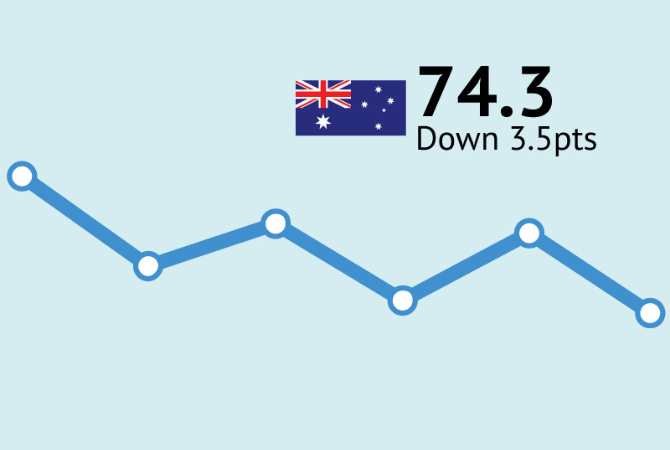ANZ-Roy Morgan Consumer Confidence plunges 3.5pts to 74.3 – after the RBA raises interest rates to 12-year high of 4.35%

ANZ-Roy Morgan Consumer Confidence dropped 3.5pts to 74.3 this week after the RBA raised interest rates by 0.25% to 4.3% - the highest official interest rates have been in 12 years.
Consumer Confidence is now at its lowest since mid-July 2023 and has spent a record 41 straight weeks below the mark of 85. Consumer Confidence is now 6.5pts below the same week a year ago, November 7-13, 2022 (80.8) and is now clearly below the 2023 weekly average of 78.0.
Looking around the States Consumer Confidence was down in NSW, Victoria, Queensland and South Australia, but up slightly against the trend in Western Australia – essentially a reverse of last week.
Driving this week’s decrease was a deterioration in people’s buying intentions after the interest rate rise and growing concerns about the long-term health of the Australian economy.
Current financial conditions
- Now a fifth of Australians, 20% (unchanged) say their families are ‘better off’ financially than this time last year compared to a majority of 54% (up 2ppts) that say their families are ‘worse off’.
Future financial conditions
- Looking forward, under a third of Australians, 28% (unchanged), expect their family to be ‘better off’ financially this time next year while 38% (up 1ppt), expect to be ‘worse off’.
Current economic conditions
- Only 7% (up 1ppt) of Australians expect ‘good times’ for the Australian economy over the next twelve months compared to two-fifths, 40% (up 2ppts), that expect ‘bad times’.
Future economic conditions
- Net sentiment regarding the Australian economy in the longer term has dropped this week with only 10% (down 1ppt) of Australians expecting ‘good times’ for the economy over the next five years compared to nearly a quarter, 24% (up 4ppts), expecting ‘bad times’ – the highest figure for this indicator for over three years since August 2020. Net sentiment for the long-term indicator at (-14) is now at its lowest since April 2020 – at the start of the COVID-19 pandemic.
Time to buy a major household item
- The burst of hope last week has been ‘snuffed out’ with buying intentions deteriorating this week following the RBA’s interest rate increase. Now only 18% (down 4ppts) of Australians say it is a ‘good time to buy’ major household items as we enter the Christmas retailing period while a growing majority of 55% (up 4ppts), say now is a ‘bad time to buy’.
ANZ Senior Economist, Adelaide Timbrell, commented:

The ANZ-Roy Morgan Australian Consumer Confidence index decreased last week to its lowest level in four months following the cash rate hike to 4.35% by the RBA. But confidence about future economic conditions – the outlook for the economy over the next five years – fell to its lowest level since April 2020. This suggests that the RBA hike may have been a negative economic signal for some households. The fall in confidence was driven by those most exposed to the rate hike, those paying off their homes and those who own their homes outright (a cohort including many who have investor mortgage debt). Continued elevated inflation is also keeping confidence low across all cohorts.

Check out the latest results for our weekly surveys on Business Confidence, Consumer Confidence, and Voting Intention as follows:
Roy Morgan Business Confidence Statistics
ANZ – Roy Morgan Consumer Confidence Statistics
Federal Voting – Government Confidence Rating
Related Research Reports
The latest Roy Morgan Consumer Confidence Monthly Report is available on the Roy Morgan Online Store. It provides demographic breakdowns for Age, Sex, State, Region (Capital Cities/ Country), Generations, Lifecycle, Socio-Economic Scale, Work Status, Occupation, Home Ownership, Voting Intention, Roy Morgan Value Segments and more
Consumer Confidence – Monthly Detailed Report in Australia.
Business Confidence – Monthly Detailed Report in Australia.
Consumer Banking Satisfaction - Monthly Report in Australia.
For comments or more information please contact:
Roy Morgan - Enquiries
Office: +61 (03) 9224 5309
askroymorgan@roymorgan.com
Margin of Error
The margin of error to be allowed for in any estimate depends mainly on the number of interviews on which it is based. Margin of error gives indications of the likely range within which estimates would be 95% likely to fall, expressed as the number of percentage points above or below the actual estimate. Allowance for design effects (such as stratification and weighting) should be made as appropriate.
| Sample Size | Percentage Estimate |
| 40% – 60% | 25% or 75% | 10% or 90% | 5% or 95% | |
| 1,000 | ±3.0 | ±2.7 | ±1.9 | ±1.3 |
| 5,000 | ±1.4 | ±1.2 | ±0.8 | ±0.6 |
| 7,500 | ±1.1 | ±1.0 | ±0.7 | ±0.5 |
| 10,000 | ±1.0 | ±0.9 | ±0.6 | ±0.4 |
| 20,000 | ±0.7 | ±0.6 | ±0.4 | ±0.3 |
| 50,000 | ±0.4 | ±0.4 | ±0.3 | ±0.2 |





